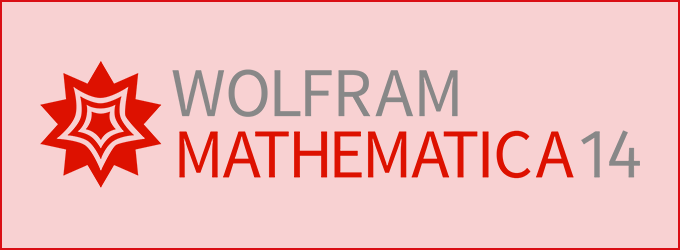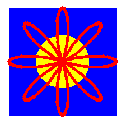GeometricaPlus
Exaktes Zeichnen und Geometrie
Geometrica ist eine Toolbox zum Erstellen von exakten Zeichnungen mit Mathematica. Entwickelt für Lehrer naturwissenschaftlicher Disziplinen an Schulen, Gymnasien und akademischen Einrichtungen, für Forscher, die exakte Zeichnungen benötigen, für Grafikdesigner, Architekten und Ingenieure im CAD-Bereich. Geometrica nutzt die symbolische Rechenengine Mathematica (ab V4) zur Definition der Geometrieregeln, damit Sie perfekte Figuren und Zeichnungen erzeugen und anhand analytischer Regeln testen können.
In Geometrica werden die geometrischen Objekte systematisch durch ihre kartesische, euklidische und parametrische Definition beschrieben. Funktionen für die dreidimensionale Geometrie wurden, wenn möglich, als Verallgemeinerung von zweidimensionalen Funktionen beschrieben und zweidimensionale Objekte können leicht in die dritte Dimension erweitert werden. Das Drittentwicklerpaket bietet eine vollständige Dokumentation mit zahlreichen farbig gedruckten und online abrufbaren Beispielen.
Features
Zusammenspiel mit Mathematica
Systemvoraussetzungen
Downloads
Anwendungsbeispiele
Preisinformation
Features von Geometrica PLUS
Zeichnen
- Basic functions in 2 D and 3 D
- Animation
- Origin of lines and planes
- Range of variations of the parameters
- Arrow
- Legend
- Painting
- Canonical view point
- Control of display
Points
- Cartesian point
- Parametric point
- Bound point
- Barycenter
- Brianchon point
- Center
- Center of curvature, of gravity and of perspective
- Circumcenter
- Excenters
- Fermat point
- Foci
- Incenter
- Line and plane origin
- Orthocenter
- Pole
- Vertices
Lines and Planes
- Cartesian line and plane
- Pencil
- Euclidean line and plane
- Conjugate line
- Conjugate plane
- Parallel
- Normal plane
- Tangent
- Altitudes
- Asymptotes
- Axes
- Axis of perspective
- Bisector
- Diagonals
- Directrices
- Euler's line
- Generators
- Imaginary, infinity and indeterminate line
- Imaginary, infinity and indeterminate plane
- Medians
- Normals
- Pascal line
- Polar
- Symmetry planes
Conics
- Cartesian conic in 2 D and 3 D
- Pencil
- Euclidean conic
- Conic elements
- Normal conic
- Imaginary and real circle
- Circumcircle
- Euler's circle
- Excircles
- Incircle
- Imaginary and real ellipse
- Parabola
- Hyperbola
Quadrics
- Cartesian quadric
- Euclidean quadric
- Quadric elements
- Sphere
- Circumsphere
- Edge sphere
- Exspheres
- Insphere
- Ellipsoid
- Quadric cone
- Elliptic cylinder
- Hyperbolic cylinder
- Parabolic cylinder
- Elliptic paraboloid
- Hyperbolic paraboloid
- Hyperboloid of one sheet
- Hyperboloid of two sheets
Curves, surfaces and volumes
- General definitions
- Parameter range
- Libraries of curves and surfaces
- Arc and strip
- Evolute of a curve
- Isolines of a surface
- Axisymmetric and ruled surfaces
- Cubic or Bezier fits
- Transformation into regions
- Wall and pipe
- Cardioid
- Cassini's ovals
- Cissoid
- Conchoid
- Cycloid
- Hypotrochoid
- Petal
- Racetrack
- Spiral
- Trochoid General cone and cylinder
- Helix
- Helicoid
- Helicoidal staircase
- Möbius' strip
- Torus
- Viviani's window
Polygons and Polyhedra
- General definitions
- Cartesian and generalized segments
- Operations on segments
- Elements of polygons and polyhedra
- Orthogonal and parallel polygons
- Special polygons and polyhedra
- Graphics complex
- Oriented segments : 2D and 3D Frenet systems
Transformations
- Affine
- Homothety
- Symmetries and inversion
- Projection and inverse projection
- Rotation
- Translation
- Shear
- Embedding a 2 D object into 3 D
- Creation of regions
Intersections
- 2 D intersections : Line, conic or polygonal line
- Line and general curve
- General curves using an interactive technique
- 3 D intersections : Coplanar lines or conics
- Plane with line, plane, polygonal line, polyhedron, quadric, cone, cylinder, general curve or surface
Affine Notions
- Barycentric coordinates
- Cartesian coordinates
- Cross and section ratios
- Sorting points on lines and conics
Metric Notions
- Angle of vectors, lines and planes
- Distance between points, parallel lines and parallel planes
- Length, curvature and torsion of curves
- Radius of circles and spheres
- Eccentricity of conics
- Areas of closed curves and surfaces
- Volume limited by a surface
Tests and Theorems
- Collinear points, segments, and straight lines
- Coplanar points, segments, straight lines and planes
- Congruent and similar triangles
- Regular polygon
- Platonic solid
- Point on line, conic, polygonal line, plane, or quadric
- Line on plane or quadric
- Segment on line, plane, or quadric
- Conic on plane or quadric
- Type of special surfaces and polyhedra
- Line, polygonal line or conic tangent to a conic
- Plane or line tangent to a quadric. Identical objects
- Theorems : Brianchon
- Desargues
- Euler
- Pappus
- Pascal
- Thales
- Villarceaux
Zusammenspiel mit Mathematica
Das Zusatzpaket integriert sich vollständig in Mathematica.
Mathematica ist ein Softwaresystem zur Lösung von Problemstellungen, in denen Berechnungen (Numerik, Symbolik), 2D- und 3D-Visualisierungen, Modellgenerierungen und Simulationen notwendig sind. Mathematica ist ein modulares mathematisches Werkzeugsystem mit einer nahezu unendlichen Vielfalt von Funktionen und Algorithmen. Es präsentiert sich dem Anwender in einer plattformunabhängigen Benutzeroberfläche - dem Notebookinterface - mit integrierter Textverarbeitung, 4GL-Programmiersprache, offener Programmarchitektur und dynamischen, frei definierbaren Symbolpaletten.
Für den erfahrenen Mathematica Anwender wird damit das Nutzen der Funktionen nahezu
zum Kinderspiel, denn jede Funktion verhält sich wie alle anderen Mathematica-Funktionen.
Für den Neuling gibt es ein interaktives Tutorial zur schnellen Einarbeitung
in Mathematica selbst und dann jeweilige Tutorials zur Einarbeitung in das Zusatzpaket.
Viele der Funktionen des Zusatzpaketes sind in Mathematica selbst programmiert und einige liegen im Mathematica Programmiercode vor, so dass diese individuell anpassbar/erweiterbar sind.
Die komplette Dokumentation ist online verfügbar und integriert sich bei der Installation in den Help-Browser und ist damit ebenfalls vollständig in Mathematica enthalten.
Erfahren Sie hier mehr zu Mathematica.
Systemvoraussetzungen
- Mathematica ab Version 10.x
- Betriebssysteme
- Windows
- MacOS X
- Linux
Downloads
Eine Tour mit Anwendungsbeispielen durch Geometrica können Sie als Mathematica Notebook oder als PDF-Datei herunterladen.
Anwendungsbeispiele
![]() Anwendungsbeispiele finden Sie auf der Seite von Wolfram Research zu GeometricaPlus.
Anwendungsbeispiele finden Sie auf der Seite von Wolfram Research zu GeometricaPlus.
Preisinformation
Geometrica Plus erhalten Sie über unseren ADDITIVE eShop oder fordern Sie ein Angebot per E-Mail
an















